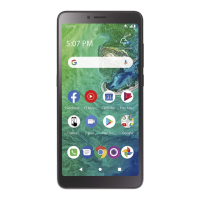
Do you have a question about the TCL A2 and is the answer not in the manual?
| Display Size | 5.5 inches |
|---|---|
| Resolution | 720 x 1440 pixels |
| RAM | 2 GB |
| Main Camera | 8 MP |
| Front Camera | 5 MP |
| Battery Capacity | 3000 mAh |
| SIM | Dual SIM |
Overview of physical buttons and ports on the device.
Initial setup procedures, including SIM card installation.
Steps for setting up the phone for the first time.
Instructions on how to turn on the mobile device.
Instructions on how to turn off the mobile device.
Explanation of touch gestures like tap, drag, and pinch.
Understanding icons and indicators in the status bar.
Accessing and managing notifications and quick settings.
Enabling/disabling common functions from the notification shade.
Using the search function for text and voice queries.
Securing the phone using patterns, PINs, or passwords.
Customizing the home screen with apps, widgets, and folders.
Accessing and managing widgets and recent app lists.
Controlling audio volume levels via keys or settings.
Details on typing, keyboard layout, and input methods.
How to edit text, copy, cut, paste, and insert new text.
Basic phone functions, including dialing and voicemail access.
Steps to make voice calls, including international and emergency calls.
How to handle incoming calls: answer, reject, or send a message.
Accessing and setting up voicemail services.
On-call functions like muting, speaker, and holding calls.
Configuring call forwarding, fixed dialing numbers, and other call options.
Handling simultaneous calls, including swapping and conferencing.
Switching between active calls.
Setting up and managing multi-party conference calls.
Reviewing past calls, call history, and missed calls.
Accessing and viewing contact details and favorites.
Organizing contacts into groups for easier management.
Steps to create and save new contact entries.
Modifying existing contact information, setting ringtones, and deleting.
Initiating calls or messages from the contact list.
Transferring contacts between SIM, storage, and other devices.
Configuring which contacts appear in the list.
Combining duplicate contact entries to avoid redundancy.
Composing new text or multimedia messages.
Details on sending MMS with attachments like photos and videos.
Viewing, replying to, and managing message threads.
Customizing notification preferences and default messaging options.
Opening and navigating the Gmail application.
Composing, attaching files, and sending emails.
Notifications and viewing incoming emails.
Responding to emails by replying or forwarding.
Configuring general and account-specific Gmail settings.
Adjusting notification actions, swipe gestures, and default replies.
Using the calendar for scheduling and tracking events.
Switching between daily, weekly, monthly, and agenda views.
Adding new appointments and events to the calendar.
Setting and receiving notifications for upcoming events.
Accessing and using the clock functions.
Setting, customizing, and managing alarms.
Detailed steps for configuring a new alarm.
Modifying alarm behavior, style, and snooze options.
Viewing time in different cities around the world.
Using the countdown timer function.
Using the stopwatch for timing events.
Methods for accessing the internet via 4G and Wi-Fi.
Using the cellular network for internet access.
Connecting to wireless networks for internet access.
Pairing and connecting with Bluetooth-enabled devices.
Enabling and disabling the Bluetooth function.
Steps for establishing a Bluetooth connection.
Transferring files between the phone and a PC via USB.
Using the phone as a hotspot or for USB tethering.
Using USB tethering to share mobile data.
Creating a Wi-Fi hotspot from mobile data.
Customizing Wi-Fi hotspot name and security settings.
Setting up and connecting to VPNs.
Configuring a new VPN connection.
Establishing and terminating VPN connections.
Instructions for capturing still photographs.
Instructions for recording video footage.
Adjusting camera settings before taking photos/videos.
Specific settings related to photo capture.
Specific settings related to video recording.
General camera settings like grid and shutter sound.
Accessing and using the app store for downloads.
Using the web browser for internet access.
Using Google Maps for navigation and location services.
Watching and sharing videos on YouTube.
Using Google Drive for file storage and synchronization.
Streaming and managing music with YT Music.
Viewing and downloading movies and TV shows.
Making video calls with Google Duo.
Managing and organizing photos and videos.
Managing Wi-Fi, cellular data, and internet connections.
Connecting to and managing Wi-Fi networks.
Settings related to mobile network and data roaming.
Monitoring and managing cellular data consumption.
Sharing the phone's internet connection.
Configuring and managing Virtual Private Network connections.
Enabling/disabling all wireless connections.
Managing connected peripherals like Bluetooth and printing.
Managing applications and their notification settings.
Controlling app permissions.
Selecting default applications for specific tasks.
Managing battery usage and display options.
Setting up screen lock, smart lock, and other security features.
Managing email and other account synchronizations.
Managing Google account and services.
Controlling privacy settings and data permissions.
System-level settings and updates.
Backing up phone settings and data to Google.
Resetting network, app preferences, or erasing all data.
Checking for and installing software updates.
Updating phone software over the air.
Essential guidelines for safe operation and avoiding hazards.
Advice on driving safety and managing radio frequency exposure.
Information on potential interference with medical devices and radiation effects.
Precautions for accessories, car connections, and product damage.
Covers device handling, heat, service, and environmental considerations.
Conditions requiring professional servicing for the device.
Guidance on avoiding extreme temperatures, moisture, and proper handling.